VSCIM486 80486DX VMEbus/STEbus CPU
A high-performance single-board solution for DOS, UNIX or real-time applications. VSCIM486 sets the pace in open-architecture bus products for industrial computing, bringing the powerful i486, i486SX and the new i486DX2 CPU to VMEbus in a form which provides unprecedented economy and flexibility to embedded- DOS, UNIX, and real-time systems designers.
Single Board Solution:
Everything the 'industrial PC' system designer needs is provided on a single board, allowing many systems to be implemented with at least one VMEbus module less than previous products. The board offers an i486DX2, i486 or the lower-cost 486SX, plus Chips & Technologies' PEAK-DM chipset for 100% compatibility with the PC-AT. In its full configuration, the board may be supplied with 68Mbytes of DRAM (2Mbytes dual- ported), a second-level 256Kbytes SRAM direct-mapped cache, 128Kbytes of battery-backed dual- ported SRAM, EPROM for System/VGA BIOS, a Super-VGA graphics controller with 1Mbyte of 80- nsec video RAM, floppy-disk and IDE hard disk controllers, keyboard interface, COM1/2 serial and LPT1 parallel ports, battery-backed real- time clock and watchdog timer. Various lower population levels are available.
Ease of configuration:
Further ways to optimise system configuration are offered by the board's six expansion interfaces - breaking new ground in flexibility for VMEbus designers. In contrast with earlier PC-AT compatible boards, this allows designers to expand functionality over the route best suited to the need - whether the requirement is driven by performance or cost objectives! This is made possible by means of a unique address mapping scheme which dynamically and transparently controls the destination of memory or I/O cycles. In addition to a full VMEbus system interface, users are provided with an optional interface to a secondary I/O bus on the outer rows of the P2 connector; this is actually an interface to STEbus, offering tremendous system flexibility especially for lowering costs in I/O-intensive systems.
Arcom's mezzanine bus called SCIM - again, an open standard - provides a highly flexible means of incrementally customising functionality - whether it's for I/O or system expansion. Further, I/O from any SCIM module is routed via a connector conforming to the industry-standard Signal- Conditioning Bus. Two routes are available for expanding memory, allowing users to add a high-speed static RAM module for use as a direct-mapped cache, or further system DRAM - up to a total of 64 Mbytes - providing the capacities for most conceivable applications. Tough, industrial orientation: This board is the culmination of years of experience in the industrial computing sector and has been designed for survival in harsh environments. For example, the Local Expansion Bus - SCIM - utilises high- density connectors which provide. strong mounting support and which can be secured for ruggedness - providing an extra dimension of system integrity compared with the flimsy proprietary daughter-module arrangements offered by some.
Further, I/O from SCIM modules can be routed directly to Eurocard-based real-world interfaces with 19-inch rack-mounting capability and screwdriver-connect terminations. The for industrial applications, matching STEbus interface is similarly designed the quality of the VMEbus itself.
Features:
- 50MHz i486DX2, 25- or 33-MHz i486 or 16- 20- or 25-MHz i486SX single board CPU
- Up to 68Mb DRAM - 2Mb dual- ported to VMEbus
- Up to 128Kb battery-backed SRAM (dual-ported to STEbus)
- Super VGA controller (1024 x 768 in 256 colours)
- Floppy disk/IDE disk controllers Keyboard, COM1/2 and LPT1 ports
- Battery-backed real-time clock Watchdog
- SCIM Local Expansion Bus and Signal Conditioning Bus interfaces
- STEbus interface (via P2)
- VMEbus interface
- All-CMOS construction
RAM/ROM Silicon disk support for ROM-based PC systems
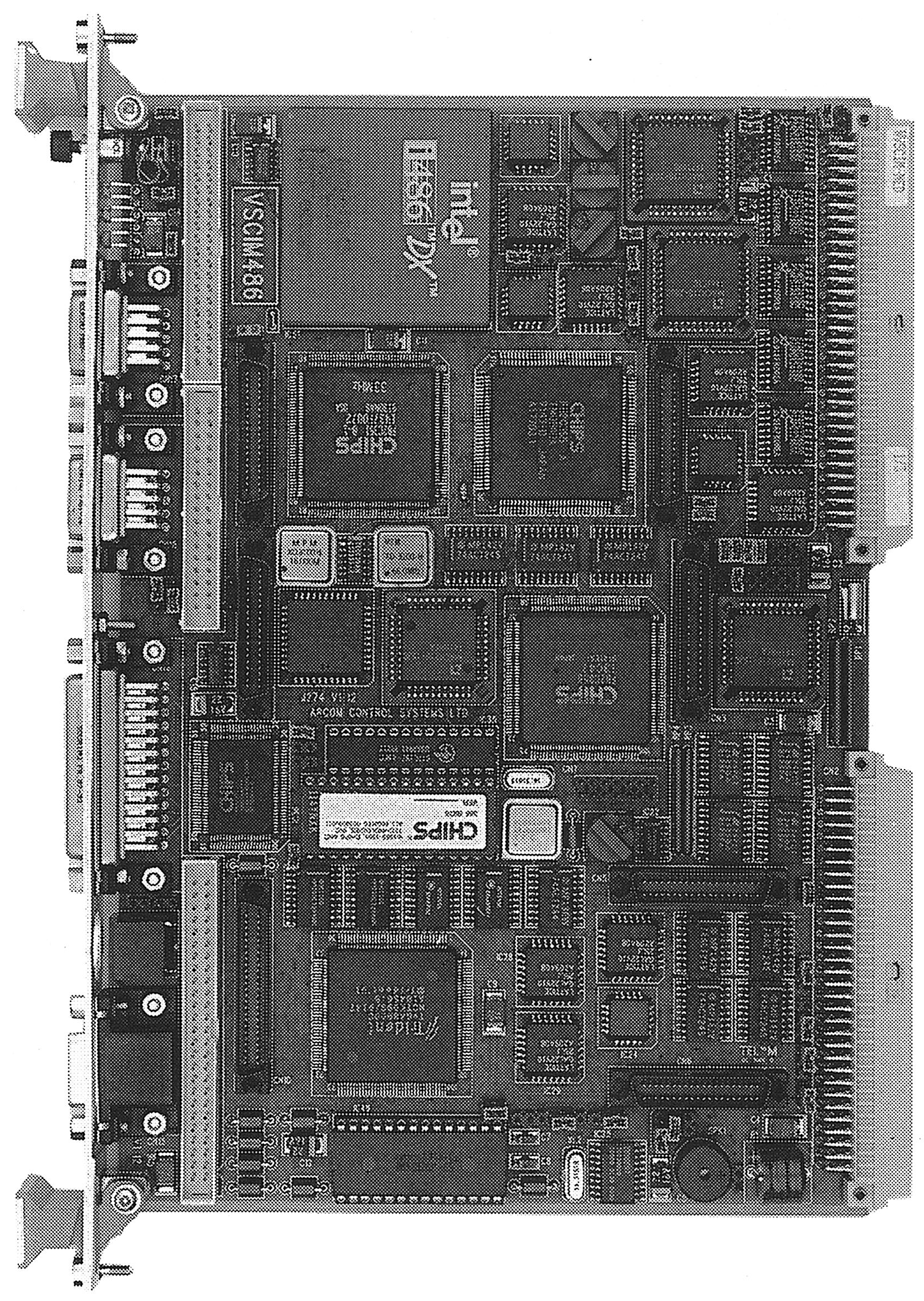
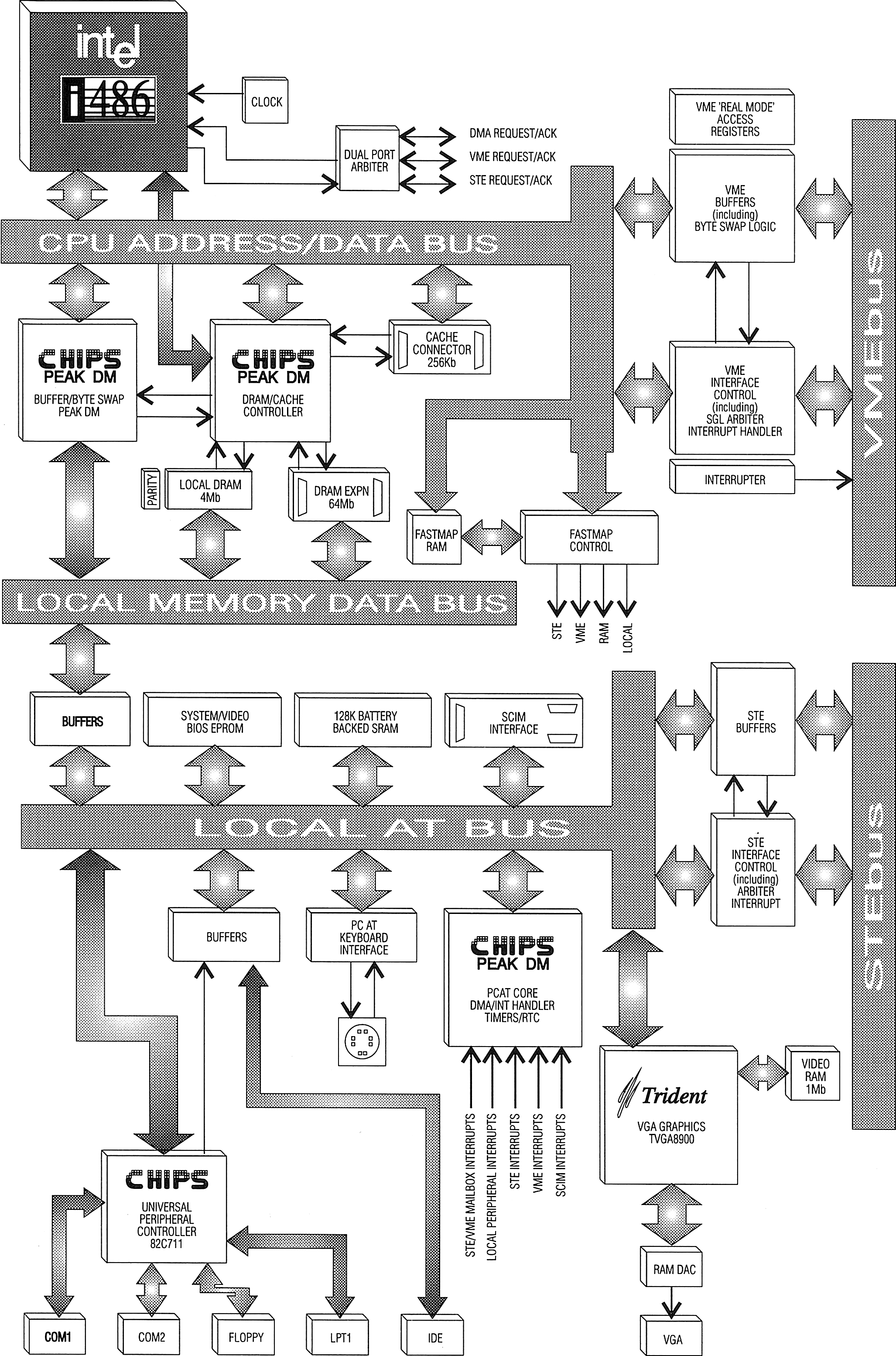
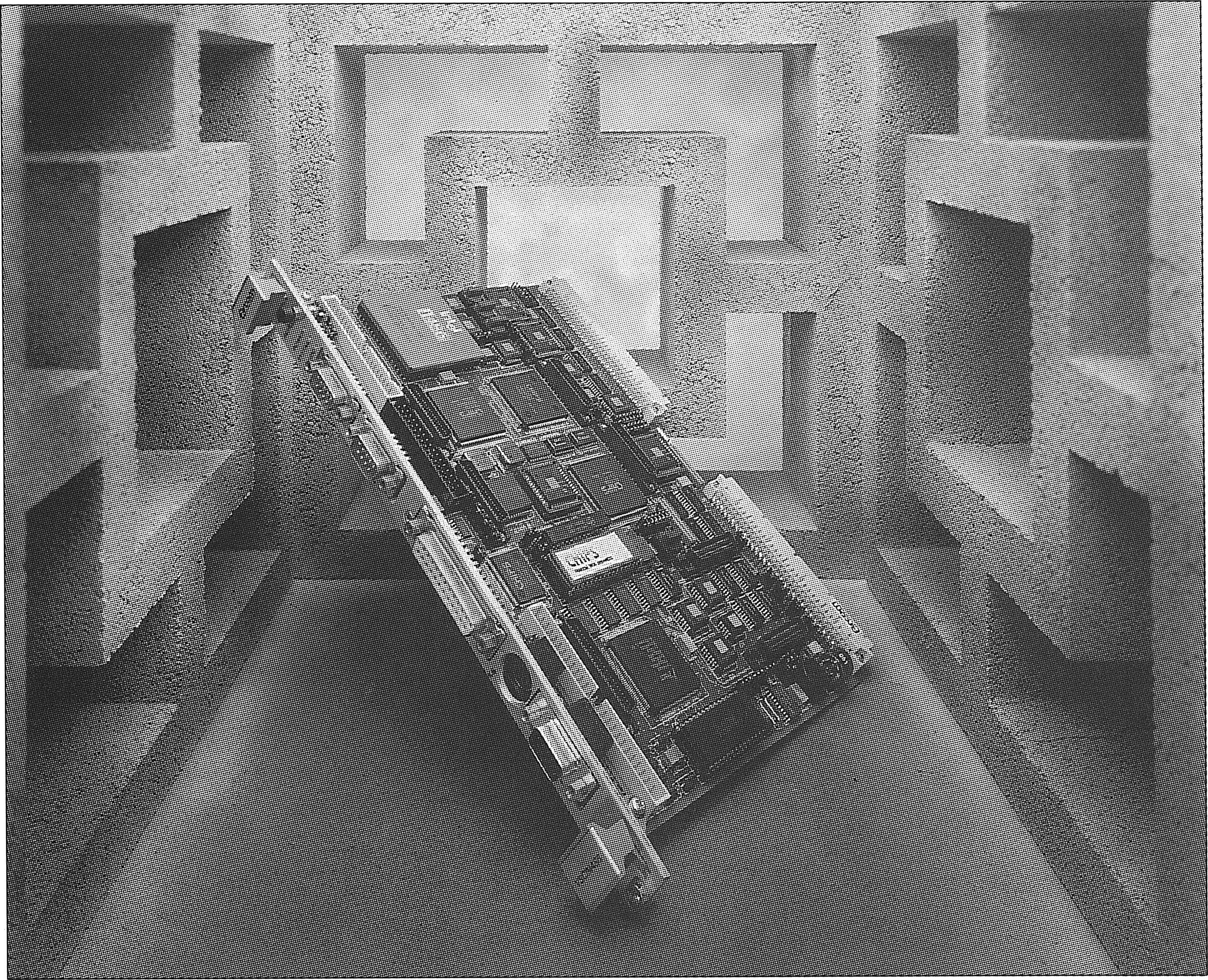
The Ultimate Industrial PC
Wide-ranging potential:
Depending on the way the feature- rich, application-flexible, capability of VSCIM486 is used, it's possible to implement many applications at lower cost- and fewer boards - than ever before, for example:
Rugged one-board PC-AT compatibles with silicon disks using just VSCIM486, with additional functions or I/O implemented via the local bus.
Workstation-style CPUs for demanding applications using VSCIM486 in conjunction with 32-bit VMEbus expansion modules make it simple to build systems to meet complex applications such as image- processing, graphics, network servers, or to provide a DOS environment for VXI testers. High-channel count industrial computers using VSCIM486 in conjunction with the STEbus port for low cost I/O.
Cost-effective UNIX engines; VSCIM486's inherent PC compatibility - in conjunction with its extensive on- board memory - provides the ability to run DOS as a window within, say, SCO's Open-Desktop graphical user interface.
PC-compatible PLCs; new-generation PLCs offer VMEbus interfaces; VSCIM486 is ideal for adding PC compatibility and enhancing flexibility.
VSCIM486 Dynamic address mapping for total design freedom:
Users of previous-generation rugged PC-AT compatibles have had to select boards with care, as the architectural decisions taken by the designers impose fundamental cost and performance constraints on the computer systems in which they are used. Arcom avoids this problem entirely, by means of a dynamic address mapping scheme called FASTmap.
It allows designers to expand board- or system-functionality over the route best suited to the need, whether the requirement is driven by performance or cost objectives - providing unprecedented design freedom.
If the target application requires large numbers of I/O channels, for example, and there are no special high throughput considerations, then STEbus is ideal. If the user is looking to minimise board count and hardware costs, then SCIM offers a highly flexible means of incrementally customising functionality. If out-and- out system performance is required, then functions can be sited on 32-bit VMEbus. Any route is possible. FASTmap utilises fast Static RAM to dynamically and transparently control the destination of memory or I/O cycles. (An example FASTmap driver routine is provided to show users how to set up the I/O map.)
FASTmap allows any PC-AT bus memory cycle in the address range A0000h - EFFFFh or an I/O cycle in range 0100h - FFFFh emanating from the Chips & Technologies' chipset to be picked up by:
- VMEbus
- STEbus
- SCIM Local Expansion Bus
- On-board resources (COM1, VGA etc)
- Battery-backed RAM (memory accesses only)
VMEbus - for optimum performance:
VSCIM486 works equally well as a PC-AT compatible - in i486's 'real' mode - or in its alternative 'protected' mode. In either guise, Arcom's comprehensive VMEbus interface provides a flexible expansion facility that users can exploit to create the optimum system.
Comprehensive data and address transfer facilities ensure flexibility of use: either half-height or full VMEbus modules may be utilised for example, and there is access to the full VMEbus addressing range - with unaligned transfers available for high performance. Further flexibility is provided by programmable byte- swapping capability for efficient communication links with other types of processor. VSCIM486 may operate as a master or slave, and can utilise VMEbus interrupter and interrupt facilities in real mode operation, facilitating the design of powerful embedded-DOS systems. PC memory areas are easily mapped onto VMEbus using FASTmap; address lines beyond the PC's 1Mbyte range are accessed via on-board registers using I/O cycles.
SCIM - for application specific bus boards:
The SCIM 'mezzanine' bus allows users to tightly match hardware to the design need, by making it possible to customise standard boards via rugged plug-on modules. You can opt for off-the-shelf SCIM functions, or design your own custom add-on. Unlike many other mezzanine buses - SCIM is designed for industrial use and is an open standard. SCIM assists in optimising performance by its closely- coupled nature, allowing functions to be sited right next to the CPU to achieve no-wait-state operation. Modules are very rugged: physical connection is implemented via two 40-way Amplimite connectors for SCIM signals, plus a 50-way connector for any signal conditioning I/O. These provide strong mounting support, and can be secured for rigidity, without affecting VMEbus inter-board spacing. I/O from modules is routed via a 50-way ribbon cable connector conforming to the industry-standard Eurocard-based Signal-Conditioning Bus. Available SCIM modules include: analogue-, serial- or digital-I/O, graphics for monitors/LCD/ plasma/EL displays, memory, networking, plus prototyping modules for development of custom functions.
Memory expansion - performance now and future security:
Two memory expansion routes allow a single VSCIM486 module to be configured for the most demanding tasks, providing inherent flexibility to handle ever-larger software and applications. Both plug-on options use the same rugged high-density connector as the mezzanine bus. System memory may be expanded above the board's base 4Mbyte level using a plug-on RAM module, providing the memory for high performance UNIX systems. Using 16Mbit DRAM devices, the module will house a total of 64Mbytes. The standard option uses 4Mbit ICS - allowing a capacity of 16Mbytes; surface-mount devices provide a more rugged approach to the widely-used clip-in SIMMs. An additional memory expansion route allows designers to add a second-level 'direct-mapped' cache. Although the i486's built-in 8K, 4-way/set-associative, facility yields excellent results and is adequate for option gives designers an extra many VSCIM486 applications, this computational edge to tackle very large-scale tasks. The module adds up to 256Kbytes.
STEbus for cost-effective I/O:
VMEbus-based I/O can work out expensive for high-channel-count industrial applications. VSCIM486 offers a solution in the form of an optional interface to the world- standard IEEE-1000 STEbus. The 8-bit STEbus is implemented on single Eurocards using the DIN41612 a/c connector - and integrates readily with VSCIM486 via the outer rows of the P2 connector. STEbus provides an exceptionally cost-effective basis for I/O-intensive control and monitoring applications. STEbus is manufacturer- independent, with advanced asynchronous data transfer, a 1Mbyte memory addressing range, 4Kbytes of I/O space, and multiple master capabilities - facilitating the design of virtually any level of I/O system - from basic minimal-cost no-frills channels, to high-performance intelligent I/O sub-systems.
VSCIM486 Specification:
- Intel i486DX2 running at 50MHz, i486 running at 25- or 33-MHz, or i486SX running at 16-, 20- or 25-MHz. The i486DX2 and i486 incorporates an on-chip floating-point maths co-processor.
- PC-AT Architecture (using Chips & Technologies' PEAK-DM chipset)
- 4Mb of system DRAM (with parity) as standard, plus up to 64Mb via local module interface
- 2Mb of system RAM dual-ported to VMEbus as A32 and A24 address slave supporting D32 (UAT), D16 and D08(OE) data transfer capability
- VMEbus mailbox interrupt generated by a write within the top of 8Kb of the 2Mb space Second-level 256Kb direct-mapped cache via a local module interface
- 128Kb of 8-bit wide system BIOS (shadowed) PC-AT bus cycles 'FASTmapped' to: local resources, SCIM, STEbus or VMEbus 16-bit SCIM interface via 50-way header 128Kb battery-backed SRAM dual-ported to STEbus on any 128Kb boundary
- STEbus mailbox interrupt generated by a write within the top 256 bytes of the 128Kb space
- 'Super' VGA graphics with 1Mb 80nsec RAM (using the TVGA8900: provides VGA to a maximum resolution of 1024 x 768 in 256 colours); analogue output
- 32Kb VGA BIOS in system BIOS ROM (shadowed) [Chips & Technologies' BIOS is supplied; offers powerful set-up facilities, simplifying hardware configuration for real- time systems]
- Battery-backed real-time clock
- Floppy disk interface via 34-way header IDE interface via 40-way header COM 1/2 ports via front-panel D9 plugs; LPT1 port via D25 socket Keyboard interface (using the 8742) via 6-pin mini-DIN connector On-board high-power mini-speaker Watchdog timer uses the 4098; provides a reset or non-maskable interrupt (inactive at reset and triggered by the first access to the watchdog location; it must then be accessed within 4 seconds)
- Front-panel reset, plus power/IDE activity/SYSFAIL status LEDs (SYSFAIL status may be read from a single I/O location, and may be driven and cleared from the VSCIM486 or via another board) Diagnostic 2-digit LED alphanumeric display via a header
- VMEbus Master: access using FASTmap scheme in 8086 real mode or directly in protected mode as a VMEbus master; A32, A24, A16 address with D32 (UAT), D16, D08 (OE) data transfer with programmable byte swapping logic (to convert between little- and big-endian formats; set by a single bit); Bus Request on 3,2,1 and 0; Single Level Arbiter (SGL); SYSCLK, SYSRST*; Slot 1 Controller; 7 Level Interrupt Handler (IH7); Interrupt Daisy Chain Driver; BTO (12μs) 7-level D08 (O) interrupter; 17 with ROAK STEbus Master: 1 Mbyte memory space (addressable from A0000h - EFFFFh); 4Kb I/O space (addressable from 100h - FFFh); Default (with Arbiter) or Potential Master (BUSRQ0/1); 6 ATNRQ* Inputs; SYSCLK, SYSRST*; 12μs BTO
- Physical: double-Eurocard (233.35 x 160mm) Power consumption: 3.1A typ; @ +5V, 10mA typ @ +12V, 5mA typ @ -12V (full i486 configuration without add-on memory any or SCIM modules, at 33MHz)
- Operating temperature range: 0 - 65°C with forced airflow.
Proven performance:
VSCIM486 offers much higher performance than boards based on 386 or 286 CPUs; some typical figures are given below; as can be seen the latest version of the i486, the i486DX2 offers a massive increase in performance making this ideal for computationally-intensive applications. Full test results, including floating-point and video performance figures, are available on request. (NB: This benchmark is for a base configuration VSCIM486 only, without second level cache fitted and is compared with typical results from comparable CPU configurations):
QAPLUS benchmark:
| CPU | MHz | Drhystones |
|---|---|---|
| 80286 | 12 | 2936 |
| 386SX | 16 | 3251 |
| 386DX | 25 | 7856 |
| i486 | 25 | 15172 |
| i486 | 33 | 22758 |
| i486DX2 | 50 | 45517 |
Ordering Information:
VSCIM486DX2/50-4 50MHz i486DX2 with 4Mb RAM VSCIM486/33-4 33MHz i486 with 4Mb RAM VSCIM486SX/16-4 16MHz i486SX with 4Mb RAM VSCIM486/25-4 25MHz i486 with 4Mb RAM VSCIM486SX/25-4 25MHz i486SX with 4Mb RAM VSCIM486SX/20-4 20MHz i486SX with 4Mb RAM DIAGPOD Diagnostic 2-digit LED alpha-numeric display
Add the required suffix for options:
-M xx RAM expansion module - with 4, 8, 16 or 32Mbytes (replace xx with required 4, 8, 16 or 32 code) -CM xx Cache expansion module - with 64, 128 or 256Kbytes (replace xx with required 64, 128 or 256 code) -ST STEbus interface with arbiter (must be factory-fitted)
For example, order code:
VSCIM486/33-4-M8-CM64
For a 33MHz VSCIM486 with a total of 12Mbytes RAM and 64Kbytes cache.
Example Configuration: VMEbus System - Disk System
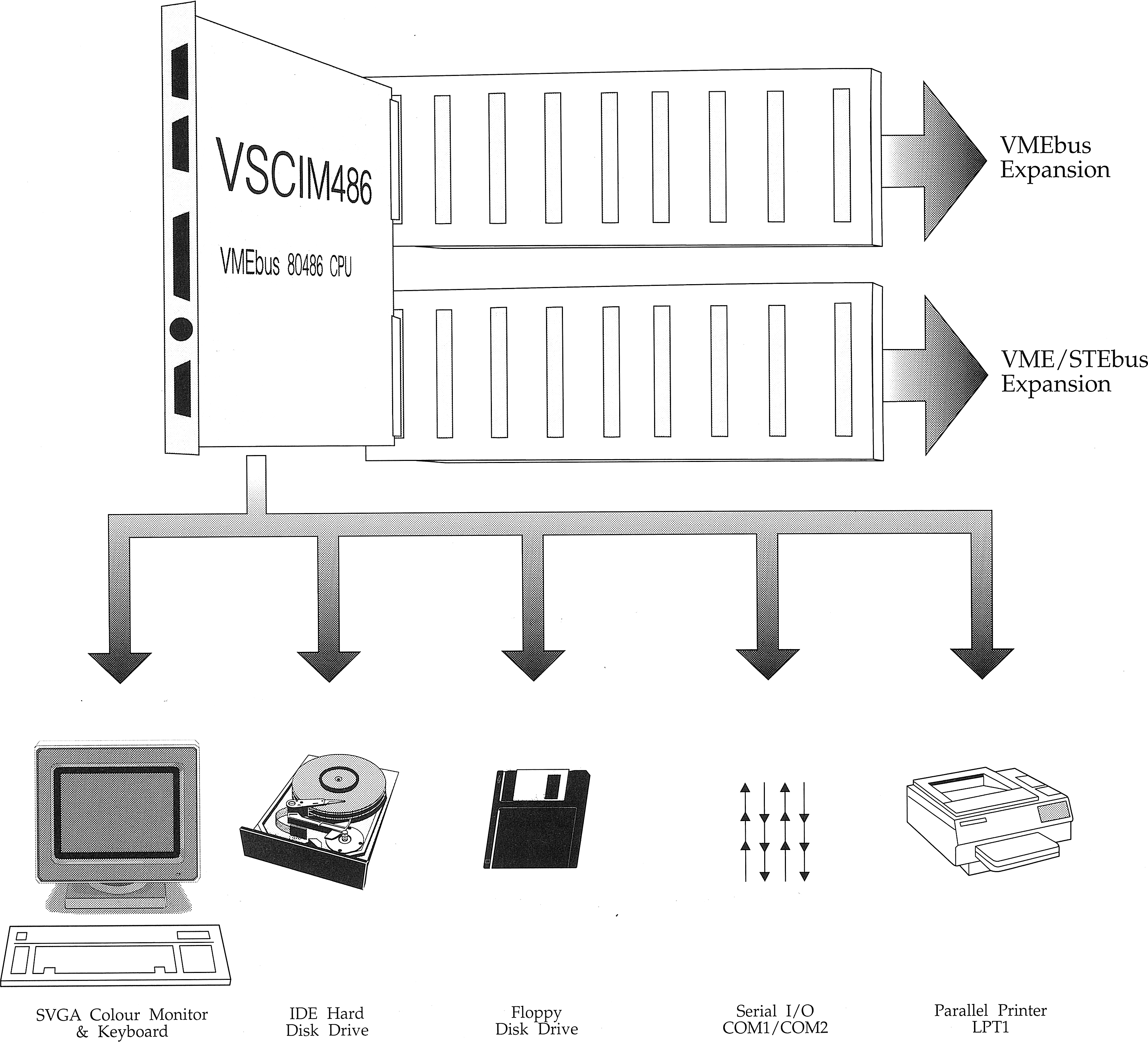
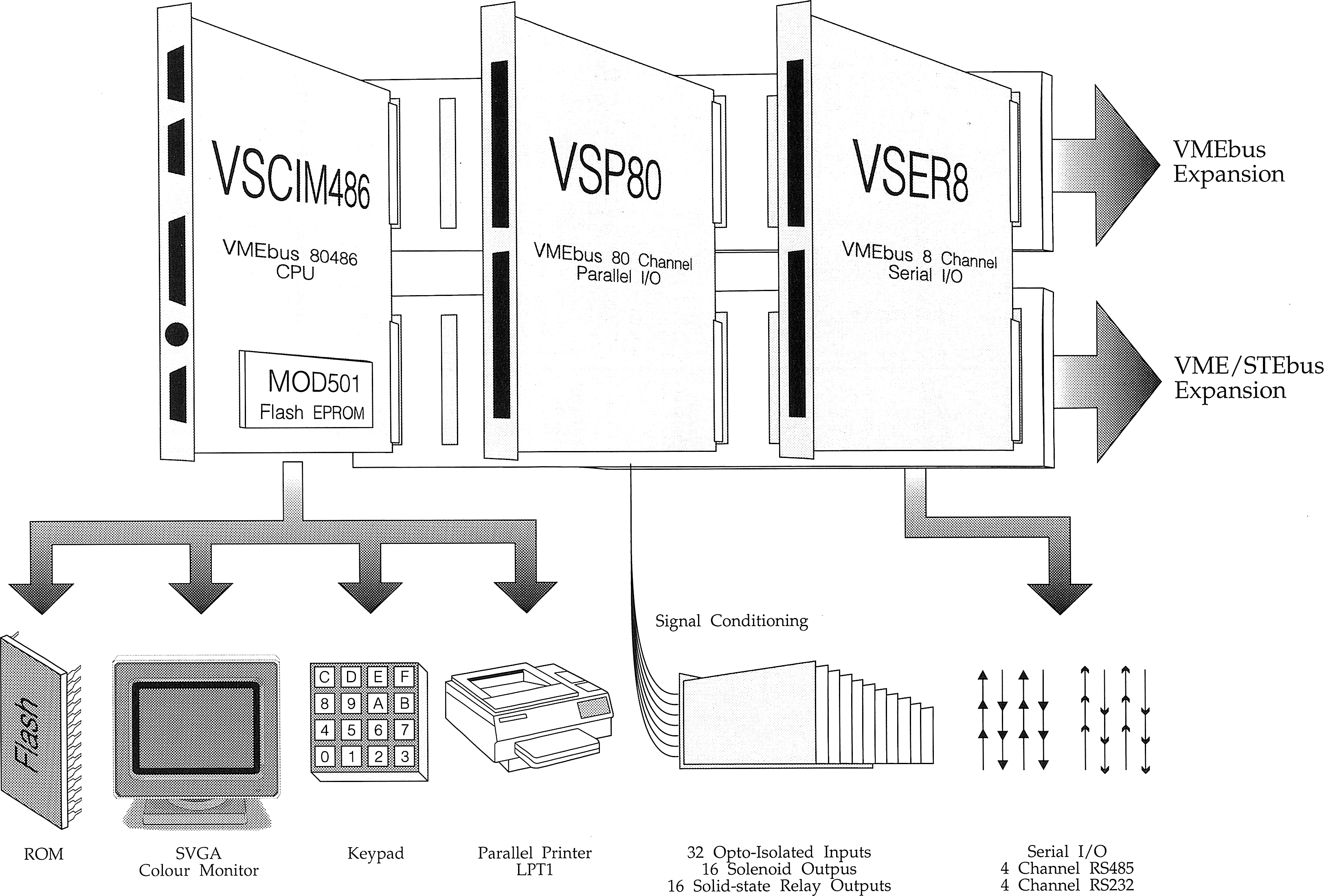
Example Configuration: VMEbus System - ROM-based
Development Systems from Arcom turn your ideas into working systems faster than ever before. They provide vital advantages; with the operating system ready-installed, you can be up-and-running in minutes, needing only to plug-in the system, keyboard and monitor to start programming. As VMEbus is processor-independent and asynchronous, it means that any board rated at any speed from any manufacturer will work with any other board, so your system will not become obsolete. If you come to the end of a project with one CPU board, you can replace it with another.
The development systems are based on robust high-quality enclosures, with easily-removable top and bottom covers. There's a high level of flexibility for the mounting of additional equipment. All systems have a switched IEC mains inlet socket with an in-line filter, a hinged front panel for easy board access, and a high-performance fan (or fans depending on configuration). Development systems are fully documented; board and system manuals are supplied in a hard-backed folder for the easy addition of manuals as the development system expands.
External dimensions: H: 310mm, W: 449mm, D: 411mm
The ARC486-33 is a VMEbus PC-AT compatible development system, based on the 33MHz VSCIM486 CPU board.
ARC486-33 Features:
- 33MHz 80486DX CPU)
- 4Mb DRAM (parity-checked))
- VGA/SVGA graphics)
- 2 serial ports (COM1/2))
- 1 parallel port (LPT1 Centronics)
- Real-time clock
- 3.5" 1.44Mb high density floppy disk drive)
- 80Mb hard disk drive (IDE) MS-DOS)
System includes:
- VSCIM486/33-4)
- VBPL9J1)
- 8 J1/J2 backplane slots free)
- VBPL9J2)
- PSU18TC)
- MS-DOS)
Ordering Information:
| (available configured for 110V, 220V or 240V operation. Please specify at time of ordering) |
| (available configured for 110V, 220V or 240V operation. Please specify at time of ordering |
Example Configuration: VMEbus/STEbus System - ROM-based
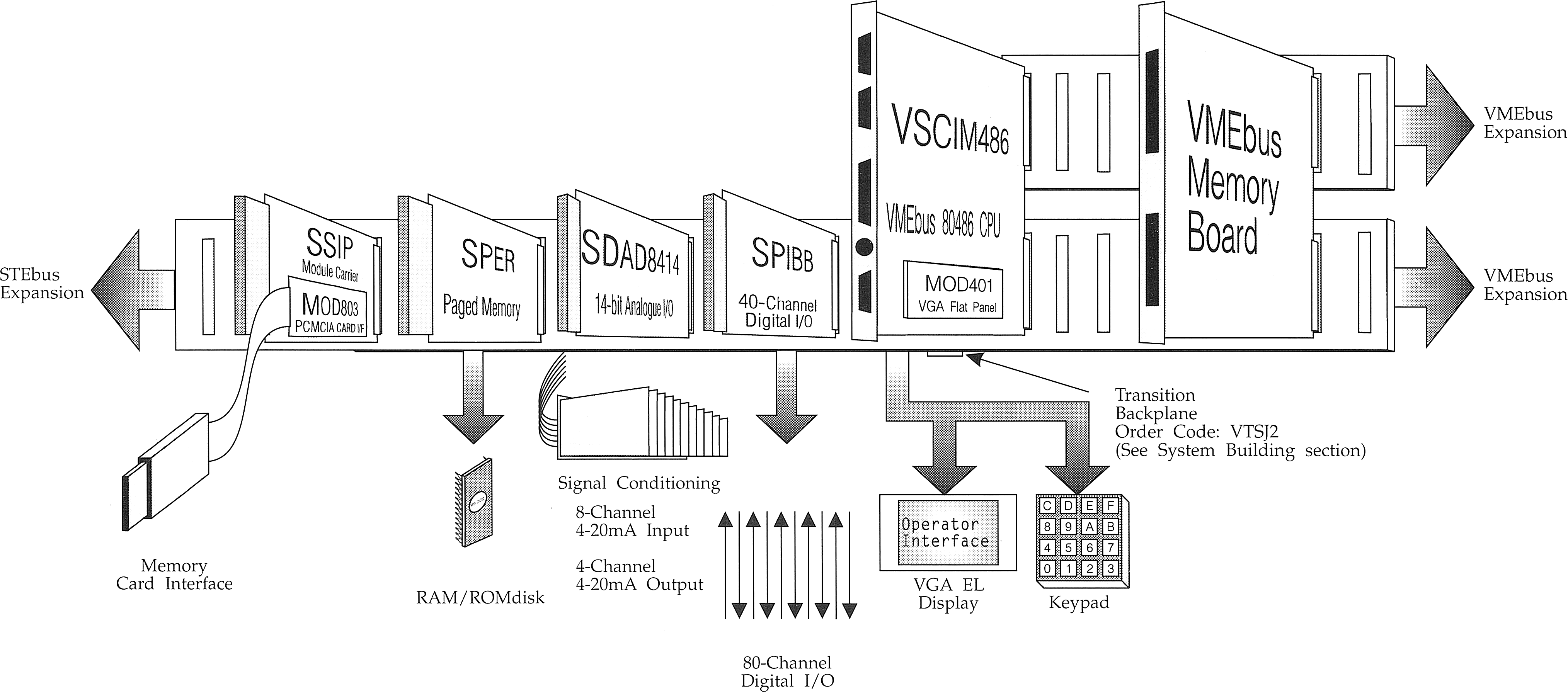
Power and Flexibility
VMEbus IEEE-1014 Standard and STEbus IEEE-1000 Standard The Optimum Open-Architecture Solution from Arcom Control Systems
Using STEbus as an I/O channel in a VMEbus system can dramatically reduce I/O costs. Use VMEbus for performance and STEbus for low-cost I/O or to act as an intelligent sub-system. A unique advantage of VMEbus/STEbus configurations is the ability to upsize or downsize across both buses as the design cycle evolves.
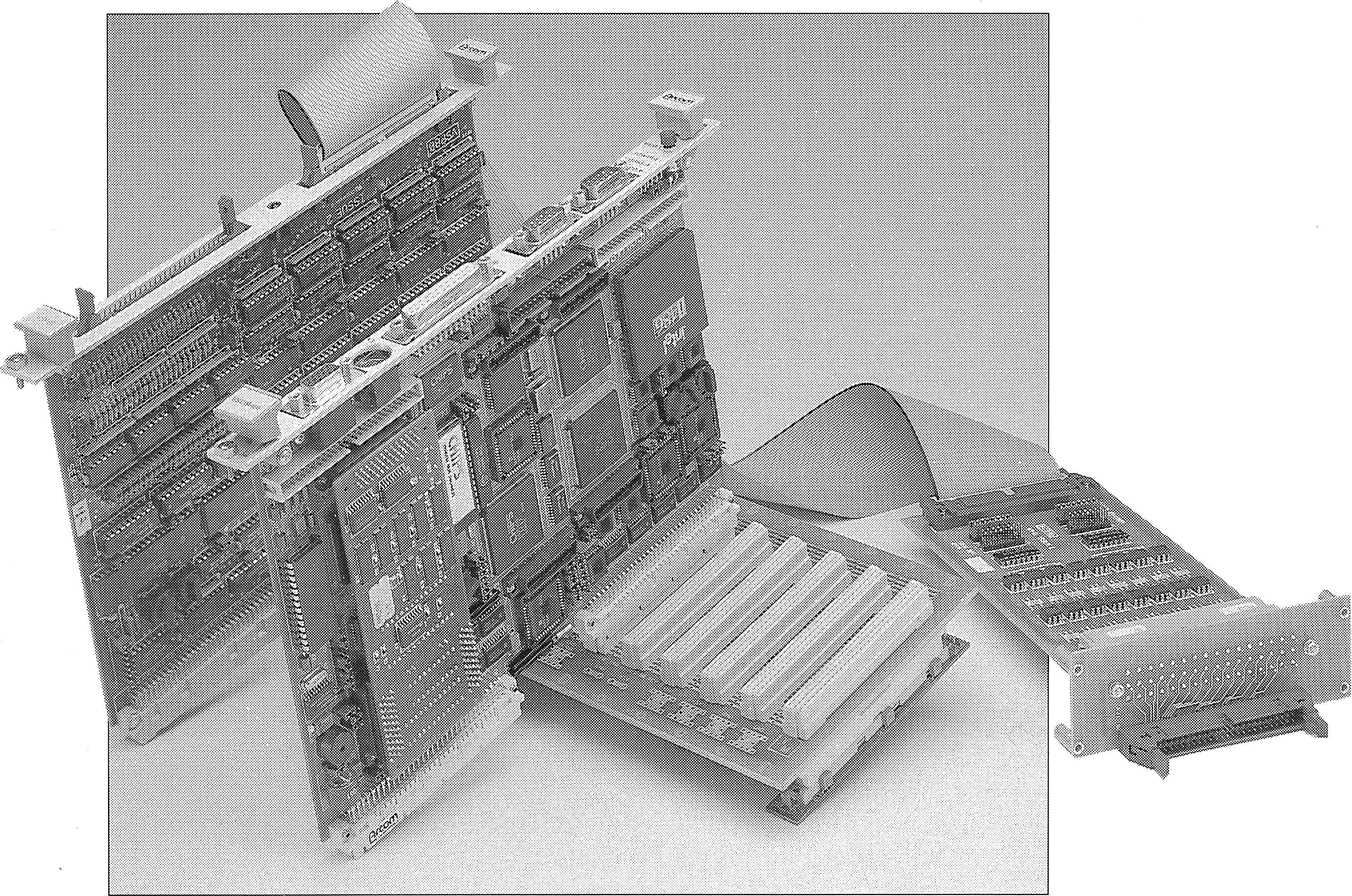
 Keith
Keith
Discussions
Become a Hackaday.io Member
Create an account to leave a comment. Already have an account? Log In.